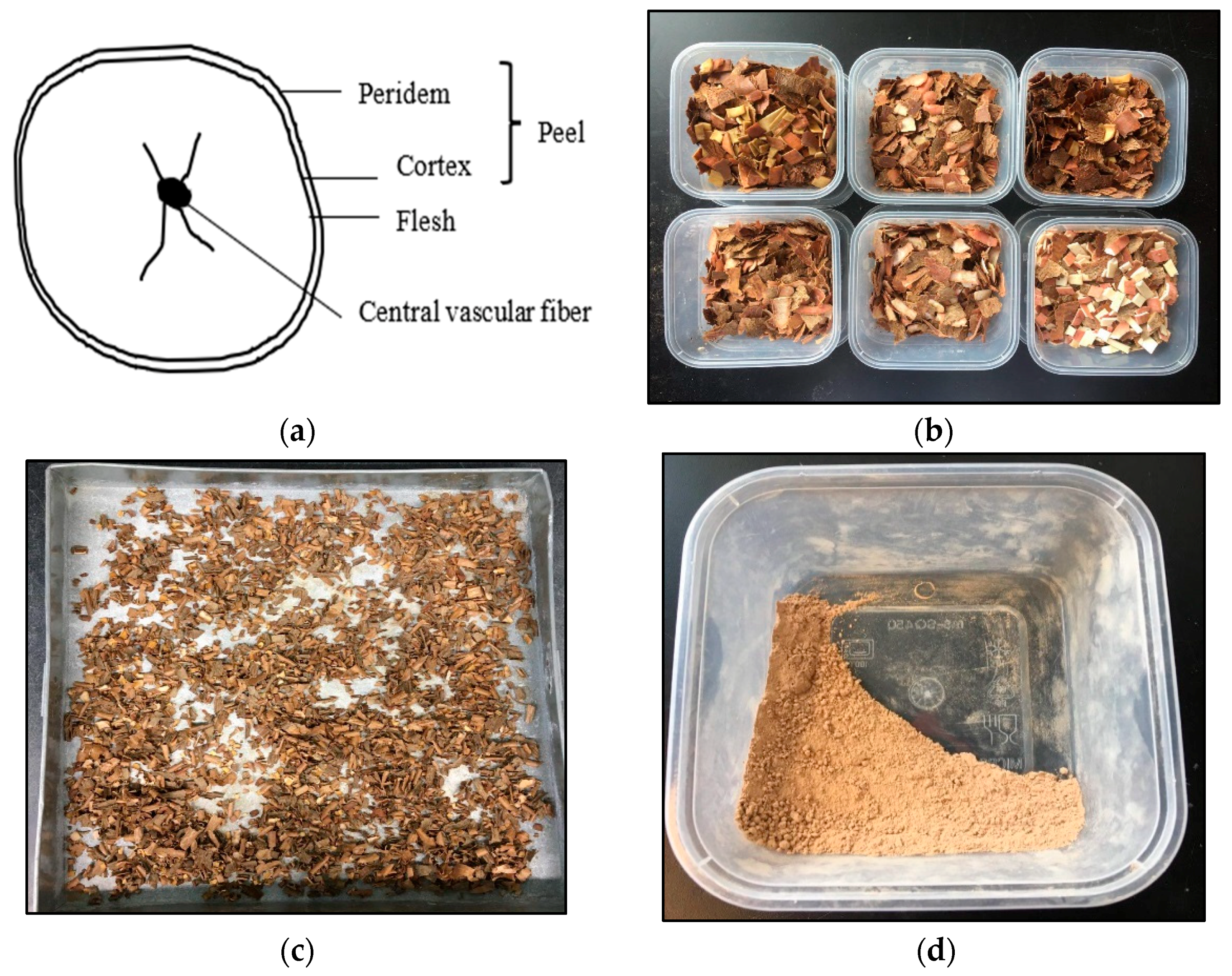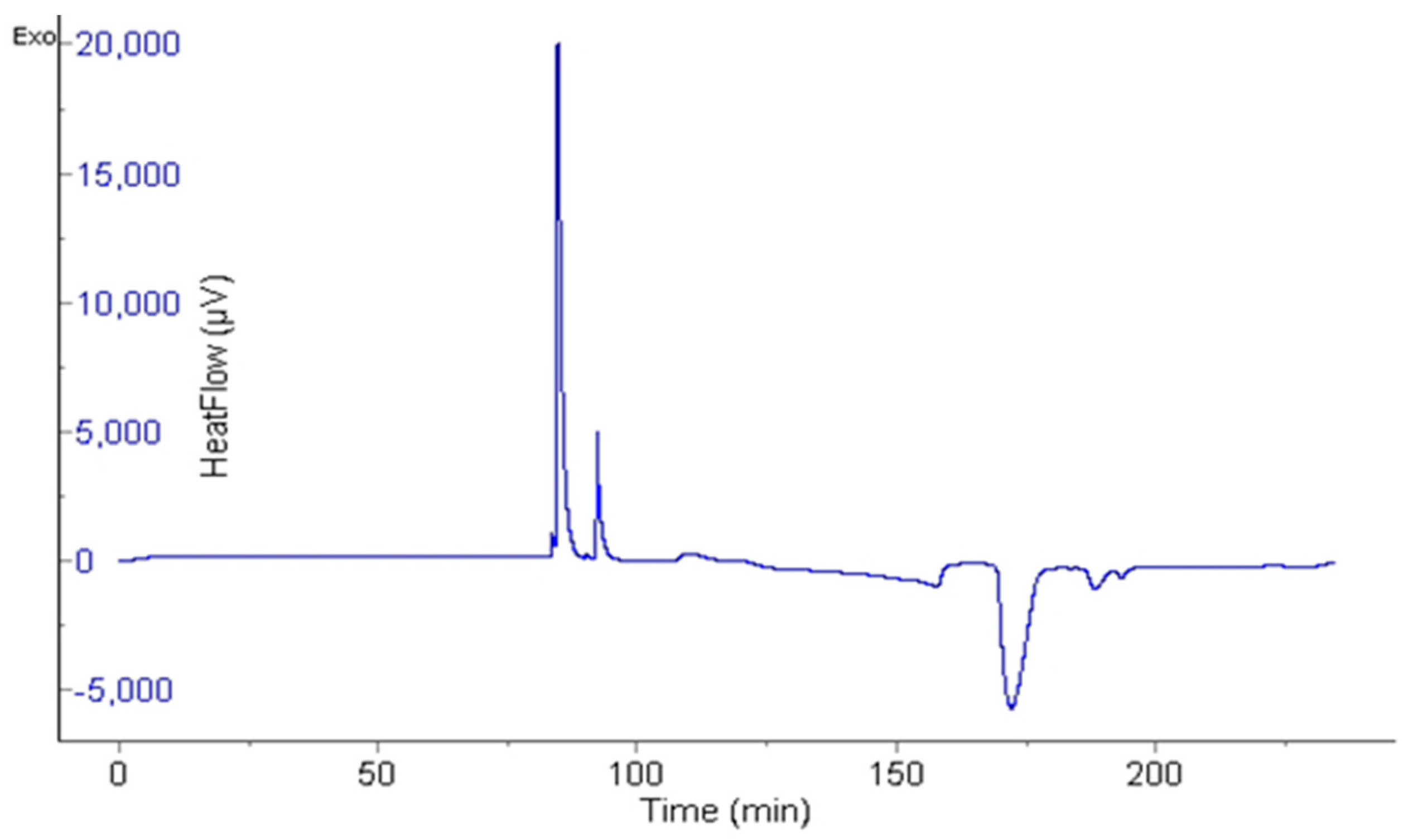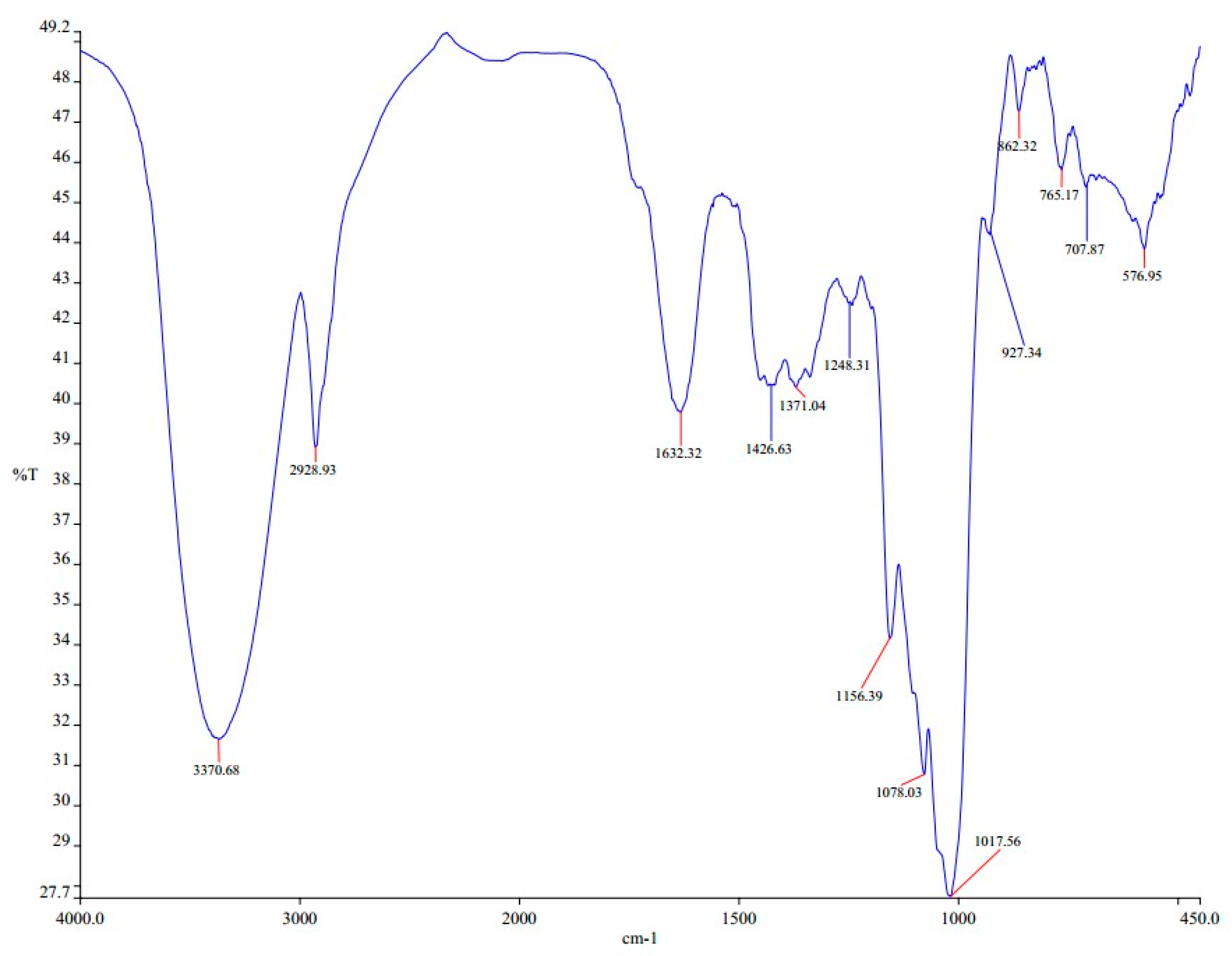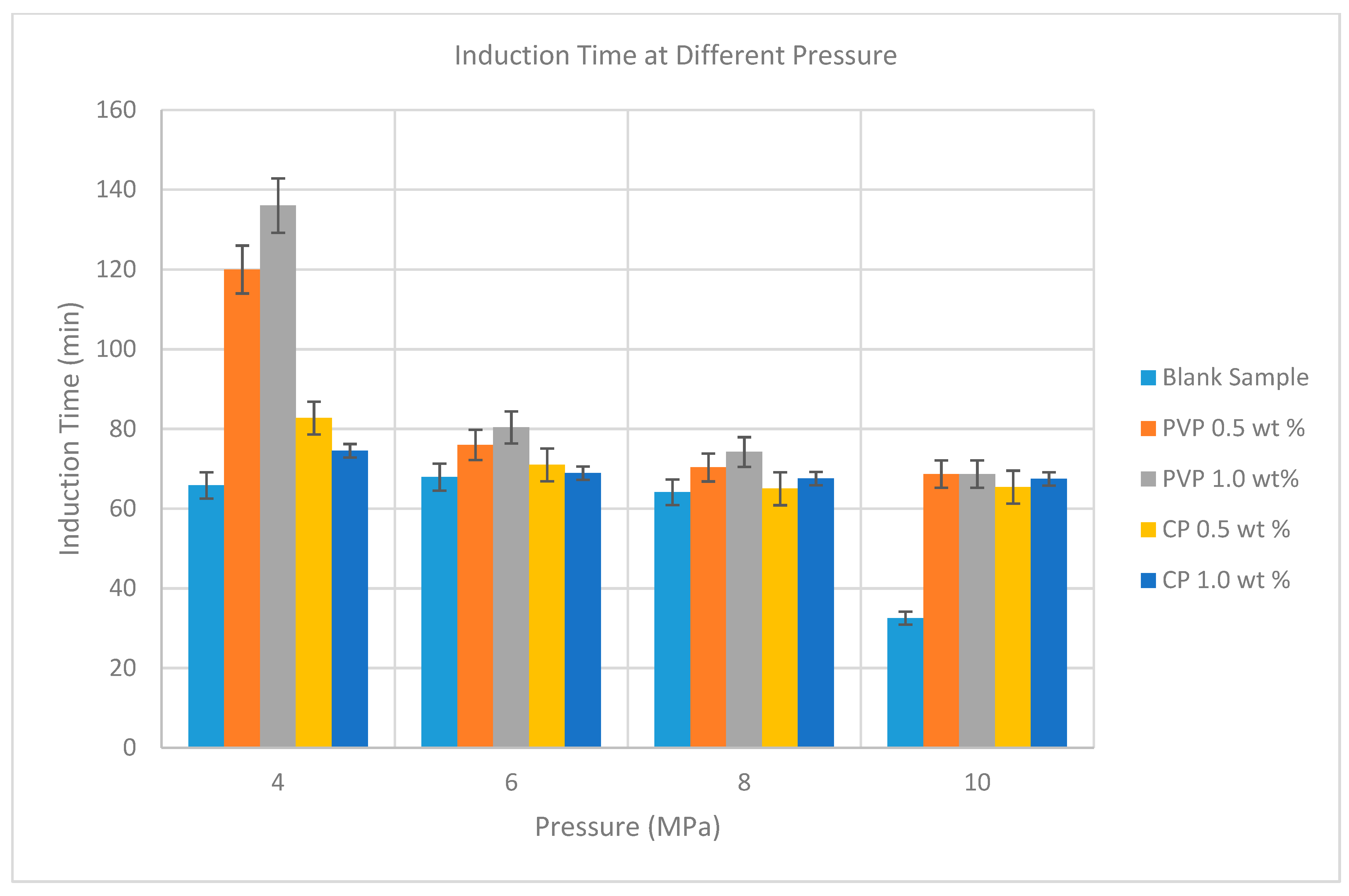Experimental Investigation of Methane Hydrate Induction Time in the Presence of Cassava Peel as a Hydrate Inhibitor
Abstract
:1. Introduction
2. Materials and Methods
2.1. Cassava Peels Preparation
2.2. Hydroxyl Group Identification Using FTIR
2.3. Morphology and Composition Identification Using SEM
2.4. Measurement of Induction Time Using µ-DSC
3. Results and Discussion
3.1. Hydroxyl Group Identification Using FTIR
3.2. Morphology and Elemental Composition Analysis Using SEM
3.3. Measurement of Induction Time Using µ-DSC
4. Conclusions
Author Contributions
Funding
Acknowledgments
Conflicts of Interest
References
- Sloan, E.D., Jr. Clathrate Hydrates of Natural Gases, Revised and Expanded; CRC Press: Boca Raton, FL, USA, 1998. [Google Scholar]
- Wang, Z.; Zhao, Y.; Zhang, J.; Pan, S.; Yu, J.; Sun, B. Flow assurance during deepwater gas well testing: Hydrate blockage prediction and prevention. J. Pet. Sci. Eng. 2018, 163, 211–216. [Google Scholar] [CrossRef]
- Lee, S.Y.; Holder, G.D. Methane hydrates potential as a future energy source. Fuel Process. Technol. 2001, 71, 181–186. [Google Scholar] [CrossRef]
- Yelisetti, S.; Spence, G.D.; Riedel, M. Role of gas hydrates in slope failure on frontal ridge of northern Cascadia margin. Geophys. J. Int. 2014, 199, 441–458. [Google Scholar] [CrossRef] [Green Version]
- Majorowicz, J.; Grasby, S.E.; Safanda, J.; Beauchamp, B. Gas hydrate contribution to Late Permian global warming. Earth Planet. Sci. Lett. 2014, 393, 243–253. [Google Scholar] [CrossRef]
- Tang, C.; Liang, D. Inhibitory effects of novel green inhibitors on gas hydrate formation. Chin. J. Chem. Eng. 2019, in press. [Google Scholar] [CrossRef]
- Wang, Y.; Fan, S.; Lang, X. Reviews of gas hydrate inhibitors in gas dominant pipelines and application of kinetic hydrate inhibitors in China. Chin. J. Chem. Eng. 2019, in press. [Google Scholar] [CrossRef]
- Yaqub, S.; Lal, B.; Partoon, B.; Mellon, N.B. Investigation of the task oriented dual function inhibitors in gas hydrate inhibition: A review. Fluid Phase Equilib. 2018, 477, 40–57. [Google Scholar] [CrossRef]
- Creek, J.L. Efficient hydrate plug prevention. Energy Fuels 2012, 26, 4112–4116. [Google Scholar] [CrossRef]
- Aminnaji, M.; Tohidi, B.; Burgass, R.; Atilhan, M. Gas hydrate blockage removal using chemical injection in vertical pipes. J. Nat. Gas Sci. Eng. 2017, 40, 17–23. [Google Scholar] [CrossRef]
- Chatti, I.; Delahaye, A.; Fournaison, L.; Petitet, J.P. Benefits and drawbacks of clathrate hydrates: A review of their areas of interest. Energy Convers. Manag. 2005, 46, 1333–1343. [Google Scholar] [CrossRef]
- Moore, J.A.; Vers, L.V.; Conrad, P. Derstanding Kinetic Hydrate Inhibitor and Corrosion Inhibitor Interactions. In Proceedings of the Offshore Technology Conference, Houston, TX, USA, 4–7 May 2009. [Google Scholar]
- Kannan, K.; Punase, A. Low Dosage, High Efficiency and Environment Friendly Inhibitors: A New Horizon in Gas Hydrates Mitigation in Production Systems. In Proceedings of the SPE International Symposium on Oil Field Chemistry, The Woodlands, TX, USA, 20–22 April 2009. [Google Scholar]
- Kamal, M.S.; Hussein, I.A.; Sultan, A.S.; von Solms, N. Application of various water soluble polymers in gas hydrate inhibition. Renew. Sustain. Energy Rev. 2016, 60, 206–225. [Google Scholar] [CrossRef] [Green Version]
- Ke, W.; Svartaas, T.M.; Kvaløy, J.T.; Kosberg, B.R. Inhibition–Promotion: Dual Effects of Polyvinylpyrrolidone (PVP) on Structure-II Hydrate Nucleation. Energy Fuels 2016, 30, 7646–7655. [Google Scholar] [CrossRef]
- Kvamme, B.; Kuznetsova, T.; Aasoldsen, K. Molecular dynamics simulations for selection of kinetic hydrate inhibitors. J. Mol. Graph. Model. 2005, 23, 524–536. [Google Scholar] [CrossRef] [PubMed]
- Idress, M.; Jasamai, M.; Yuhaznel, F.N.; Peng, W.; Karimi, N. Preliminary study of natural polymer as kinetic hydrate inhibitor. Mater. Today Proc. 2018, 5, 21667–21671. [Google Scholar] [CrossRef]
- Morgan, N.K.; Choct, M. Cassava: Nutrient composition and nutritive value in poultry diets. Anim. Nutr. 2016, 2, 253–261. [Google Scholar] [CrossRef] [PubMed]
- Ubalua, A.O. Cassava wastes: Treatment options and value addition alternatives. Afr. J. Biotechnol. 2007, 6, 2065–2073. [Google Scholar] [CrossRef]
- Bhatnagar, A.; Sillanpää, M.; Anna, W.K. Agricultural waste peels as versatile biomass for water purification—A review. Chem. Eng. J. 2015, 270, 244–271. [Google Scholar] [CrossRef]
- Adekunle, A.; Orsat, V.; Raghavan, V. Lignocellulosic bioethanol: A review and design conceptualization study of production from cassava peels. Renew. Sustain. Energy Rev. 2016, 64, 518–530. [Google Scholar] [CrossRef]
- Xu, S.; Fan, S.; Fang, S.; Lang, X.; Wang, Y.; Chen, J. Pectin as an extraordinary natural kinetic hydrate inhibitor. Sci. Rep. 2016, 6, 23220. [Google Scholar] [CrossRef]
- Xu, Y.; Yang, M.; Yang, X. Chitosan as green kinetic inhibitors for gas hydrate formation. J. Nat. Gas Chem. 2010, 19, 431–435. [Google Scholar] [CrossRef]
- Merkel, F.S.; Schmuck, C.; Schultz, H.J. Investigation of the influence of hydroxyl groups on gas hydrate formation at pipeline-like conditions. Energy Fuels 2016, 30, 9141–9149. [Google Scholar] [CrossRef]
- Asharuddin, M.S.; Othman, N.; Zin, N.S.M.; Tajaruddin, H.A. A chemical and morphological study of cassava peel: A potential waste as coagulant aid. In Proceedings of the International Symposium on Civil and Environmental Engineering 2016 (ISCEE 2016), Melaka, Malaysia, 5 December 2016. [Google Scholar]
- Kusumayanti, H.; Handayani, N.A.; Santosa, H. Swelling power and water solubility of cassava and sweet potatoes flour. Procedia Environ. Sci. 2015, 23, 164–167. [Google Scholar] [CrossRef]
- Maeda, N.; Kelland, M.A.; Wood, C.D. Ranking of kinetic hydrate inhibitors using a high pressure differential scanning calorimeter. Chem. Eng. Sci. 2018, 183, 30–36. [Google Scholar] [CrossRef]
- Mutalib, M.A.; Rahman, M.A.; Othman, M.H.D.; Ismail, A.F.; Jaafar, J. Scanning Electron Microscopy (SEM) and Energy-Dispersive X-Ray (EDX) Spectroscopy. In Membrane Characterization; Elsevier: Amsterdam, The Netherlands, 2017; pp. 161–179. [Google Scholar]
- Gupta, A.; Lachance, J.; Sloan, E.D., Jr.; Koh, C.A. Measurements of methane hydrate heat of dissociation using high pressure differential scanning calorimetry. Chem. Eng. Sci. 2008, 63, 5848–5853. [Google Scholar] [CrossRef]
- Nashed, O.; Sabil, K.M.; Ismail, L.; Japper-Jaafar, A.; Lal, B. Mean induction time and isothermal kinetic analysis of methane hydrate formation in water and imidazolium based ionic liquid solutions. J. Chem. Thermodyn. 2018, 117, 147–154. [Google Scholar] [CrossRef]
- Bavoh, C.B.; Lal, B.; Keong, L.K.; Binti Jasamai, M.; Binti Idress, M. Synergic kinetic inhibition effect of EMIM-Cl+PVP on CO2 hydrate formation. Procedia Eng. 2016, 148, 1232–1238. [Google Scholar] [CrossRef]







| Absorption | Functional Group | Compound Class |
|---|---|---|
| 3700–3584 | O–H stretching | Alcohol |
| 3550–3200 | O–H stretching | Alcohol |
| 3500 | N–H stretching | Primary amine |
| Element | Compound | Weight (%) | Atomic (%) |
|---|---|---|---|
| C | CaCO3 | 71.50 | 77.09 |
| O | SiO2 | 28.12 | 22.76 |
| Al | Al2O3 | 0.10 | 0.05 |
| Si | SiO2 | 0.09 | 0.04 |
| K | Potassium feldspar | 0.19 | 0.06 |
| Totals | - | 100.00 | 100.00 |
| Sample | Pressure (MPa) | Induction Time (min) |
|---|---|---|
| Without inhibitor (blank sample) | 4.0 | 65.84 |
| 6.0 | 67.92 | |
| 8.0 | 64.14 | |
| 10.0 | 32.54 |
| Pressure (MPa) | Concentration (wt %) | No of Runs | Average Induction Time for PVP (min) | Average Induction Time for CP (min) |
|---|---|---|---|---|
| 4.0 | 0.5 | 3 | 120.00 | 82.73 |
| 4.0 | 1.0 | 3 | 136.00 | 74.54 |
| 6.0 | 0.5 | 3 | 76.00 | 70.97 |
| 6.0 | 1.0 | 3 | 80.40 | 68.92 |
| 8.0 | 0.5 | 3 | 70.33 | 65.00 |
| 8.0 | 1.0 | 3 | 74.22 | 67.55 |
| 10.0 | 0.5 | 3 | 68.70 | 65.40 |
| 10.0 | 1.0 | 3 | 70.52 | 67.46 |
© 2019 by the authors. Licensee MDPI, Basel, Switzerland. This article is an open access article distributed under the terms and conditions of the Creative Commons Attribution (CC BY) license (http://creativecommons.org/licenses/by/4.0/).
Share and Cite
Idress, M.; Shahril, M.A.; Zuraidin, A.S.; Jasamai, M. Experimental Investigation of Methane Hydrate Induction Time in the Presence of Cassava Peel as a Hydrate Inhibitor. Energies 2019, 12, 2314. https://doi.org/10.3390/en12122314
Idress M, Shahril MA, Zuraidin AS, Jasamai M. Experimental Investigation of Methane Hydrate Induction Time in the Presence of Cassava Peel as a Hydrate Inhibitor. Energies. 2019; 12(12):2314. https://doi.org/10.3390/en12122314
Chicago/Turabian StyleIdress, Mazlin, Muhammad Afiq Shahril, Ahmad Syahir Zuraidin, and Mazuin Jasamai. 2019. "Experimental Investigation of Methane Hydrate Induction Time in the Presence of Cassava Peel as a Hydrate Inhibitor" Energies 12, no. 12: 2314. https://doi.org/10.3390/en12122314
APA StyleIdress, M., Shahril, M. A., Zuraidin, A. S., & Jasamai, M. (2019). Experimental Investigation of Methane Hydrate Induction Time in the Presence of Cassava Peel as a Hydrate Inhibitor. Energies, 12(12), 2314. https://doi.org/10.3390/en12122314





